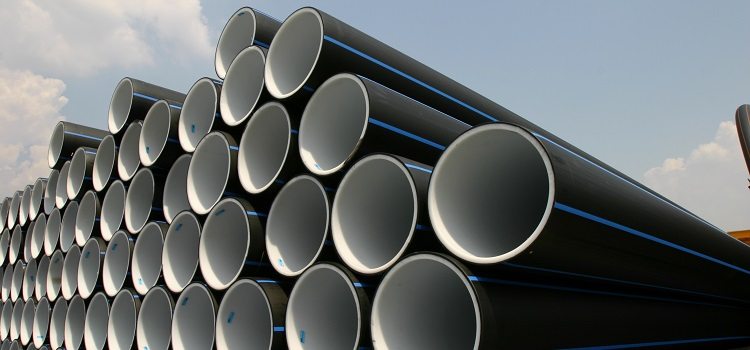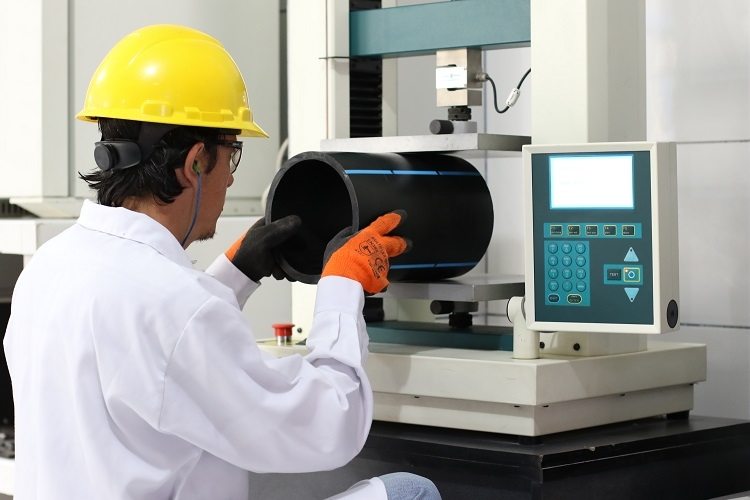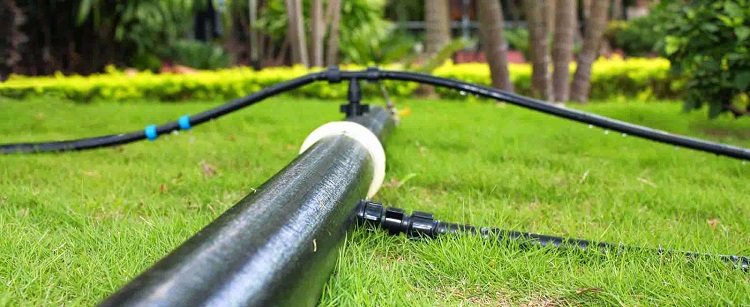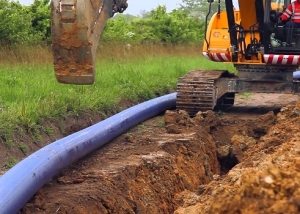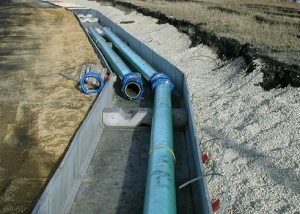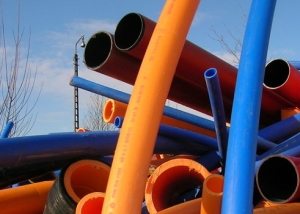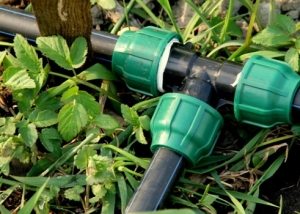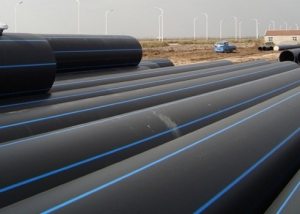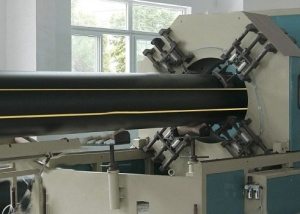Water pipes made of polyethylene can be used to carry almost all types of liquids, since they do not react with most substances. Such products are widely used for laying highways of both cold and hot water supply (with carrier temperature up to 40 ° C) in a private house or in a country house (especially in the ground). When installing pressure pipes, one-piece and detachable joints are used.
Content
The main features of the material
Ethylene is an organic compound used in the chemical industry. It is used for the production of polyethylene (PE) by polymerization. There are 2 technological processes:
- Obtaining low pressure polyethylene (HDPE) at a temperature of 120-150 ° C and a pressure of 0.1-2 MPa.
- Obtaining high pressure polyethylene (LDPE) at a temperature of 200-260 ° C and a pressure of 150-300 MPa.
HDPE (or HDPE - High Density Polyethylene) has high strength and density. LDPE (or LPDE - Low Density Polyethylene) is a low-density material characterized by softness, ductility, and ductility.
Technical HDPE pipes can be used at the cottage for sewage networks, water disposal, as protective ducts, for laying electric cables, etc. HDPE water pipes are black, this is their distinguishing feature.
When laying in the ground at the dacha of a water supply network, it is necessary to ensure that trench depth was lower than the freezing point of the soil, and the width was the minimum necessary for the location of the pipe.
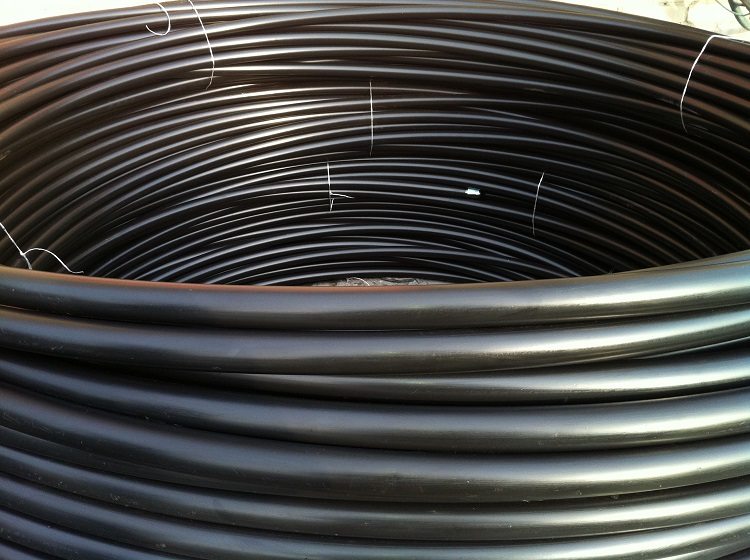
Pipes made of low pressure polyethylene are suitable for laying an underground water supply in a country house
Note! It is optimal to place a pipeline section in the ground that has no connections.
Production of polyethylene pipes
The production of polyethylene water pipes, the technical characteristics of which are determined by the properties of the material and the choice of technology, is based on three different methods:
- suspension;
- mortar;
- gas phase.
In the first technology, the monomer is polymerized in a dispersion medium (most often water). This process is accompanied by the formation of a suspension with a particle size of from 50 to 150 nm. The solution method is similar to the previous one, but the polymerization takes place in an organic solution. Gas-phase technology involves the appearance of the gas phase of the monomer.
All three methods make it possible to obtain high strength material with strong intermolecular bonds due to the low level of branching of molecules. Technical characteristics of polyethylene and its structure depend on the type of technology used.
Depending on the nominal pressure, polyethylene pipes are available in 7 versions: SDR-9; SDR-11; SDR-13.6; SDR-17; SDR-17.6; SDR-21 and SDR-26.
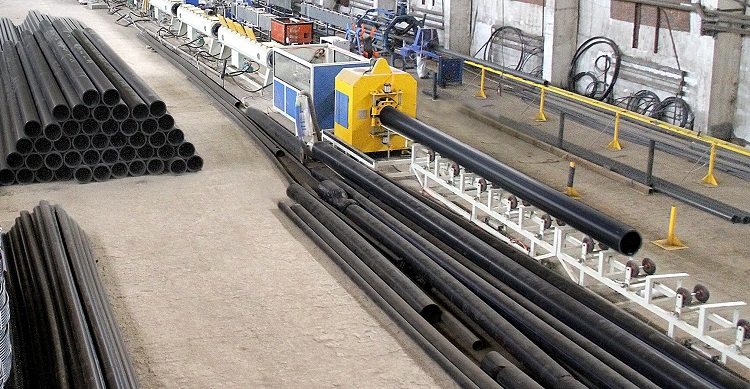
Technologies for the production of HDPE pipes make it possible to obtain products with different wall thicknesses for different types of pipelines
Product Requirements
HDPE pipes for water supply - products that are made of polyethylene with a diameter of 1-120 cm at a low pressure value (0.1-2 MPa). Their production complies with GOST 18599 - 2001.
Regulatory documents determine the technical and operational characteristics and standards for HDPE water pipes:
- The outer, end and inner surfaces should be smooth without cracks, third-party inclusions and sinks.
- The maximum maintained working pressure makes up to 16 or 20 atmospheres.
The diameters of HDPE water pipes that meet the above requirements can vary from 1.6 to 160 cm. The supply of such products is in the form of bays of 200 and 100 meters or in the form of straight sections of 12 m.
Marking of the PND pipe is carried out by blue stripes (at least 3), uniformly distributed around its circumference. The working temperature of the products is from -20 to +40 ° C. The maximum temperature values for water PE pipes are from -70 to +80 ° С. The tensile strength of products is 38 MPa.
Characteristics of HDPE pipes that determine their choice
For HDPE pipes, three main parameters are distinguished:
- brand of polyethylene;
- SDR score
- diameter.
There are 3 grades of polyethylene: PE-63, PE-80 and PE-100. PE-80 products are capable of withstanding significant internal pressure. They are well suited for water supply with a cross section of up to 9 cm. PE-100 water pipes are used for laying cold water supply systems in the country and are made on the basis of PE-80.
Such products with a smaller diameter can provide the required throughput. Pipes made of PE-100 are characterized by a maximum tensile strength under internal tension of 1 thousand hours and resistance to mechanical stress. SDR is determined by the ratio of pipe diameter to wall thickness. For HDPE products for water supply, a lower SDR value means higher product strength.
Helpful advice! For private use in the country, the diameters of the PND water pipes for cold water supply of 25 or 20 mm are sufficient. If the daily water consumption is large (for example, for watering the garden), then you can take pipes 3.2 cm in diameter.
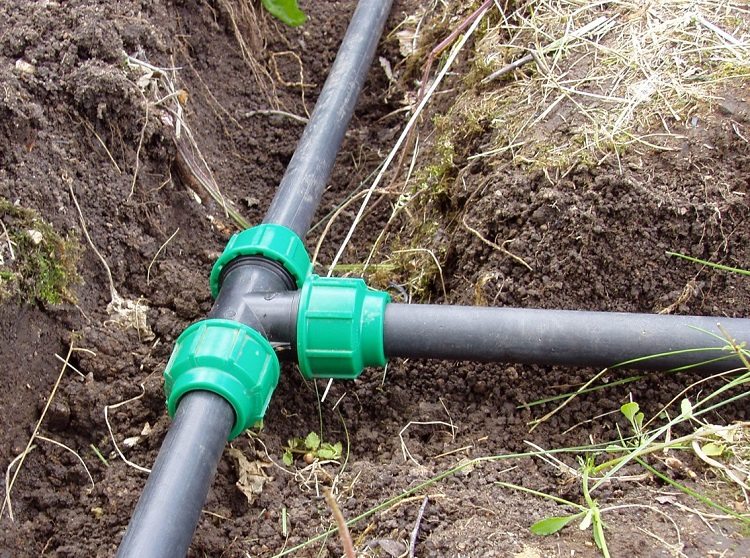
For the arrangement of the water supply in summer conditions, PND pipes of small diameter are enough
Technical characteristics of polyethylene products
Technical characteristics of HDPE pipes for water supply are given in the table.
Table 1
| Diameter mm | 40 | 32 | 25 | 20 |
| SDR | SDR9 / SDR11 | |||
| Wall thickness mm | 4,5/3,7 | 3,6/3,0 | 2,8/2,3 | 2,3/2,0 |
| Maximum working pressure, MPa | 1,6/1,25 | |||
| Mass of 1 running meter, kg | 0,3-0,5 | 0,2-0,3 | 0,15-0,2 | 0,12 |
Technical indicators for pipes of all grades and sizes are indicated on average in the table.
table 2
| Index | Value | unit of measurement |
| specific heat | 2300-2700 | J / (kg * K) |
| melting temperature | 120-135 | ° C |
| frost resistance | -70 | ° C |
| density | 948-960 | kg / m3 |
| melt flow | 0,1-15 | g / 10 min |
| tensile strength | 0,019-0,026 | GPa |
| Breaking stress | ||
| tensile | 0,018-0,032 | GPa |
| under compression | 0,02-0,036 | GPa |
| when bending | 0,02-0,04 | GPa |
| Elastic modulus | ||
| when bending | 0,636-0,735 | kPa |
| tensile | 0,61-0,75 | kPa |
| water absorption per day at 23 ° C | 0,01 | % |
| coefficient of thermal conductivity | 420-440 | mW / (m * K) |
| crystallinity | 70-85 | % |
Advantages of polyethylene pressure pipes
Polyethylene products have advantages over other types of pipes made of metal, cast iron or concrete. They have a long service life (50 years), are resistant to corrosion and aggressive environments, which makes them the best choice for use in the country. A polyethylene water pipe is 3-4 times lighter than a metal or cast-iron pipe.
The speed and ease of installation are achieved using thermistor fittings, reducing the cost of butt welding. In addition, the release of polyethylene pipes for water supply with a section of 2-11 cm in bays that contain a length of 50-1000 m, reduces the amount of consumables.
Product characteristics allow laying in the ground at the cottage, due to their high elasticity and ability to withstand changes in soil loads.There is no need to insulate the polyethylene water pipe, since it is frost-resistant and can be operated at temperatures up to -70 ° C.
Note! The hydraulic properties of the water supply system are preserved if pressure polyethylene products of an order of magnitude smaller diameter are used due to their inner surface with low roughness.
HDPE pipe has a relatively low modulus of elasticity, which significantly reduces the risk of water hammer. Pressure head water polyethylene pipes toxicologically and bacteriologically safe.
Pipe Connection Options
There are several ways to connect water PE pipes:
- by welding;
- using compression fittings;
- electrodiffusion welding using thermoresistive fittings;
- flange connection.
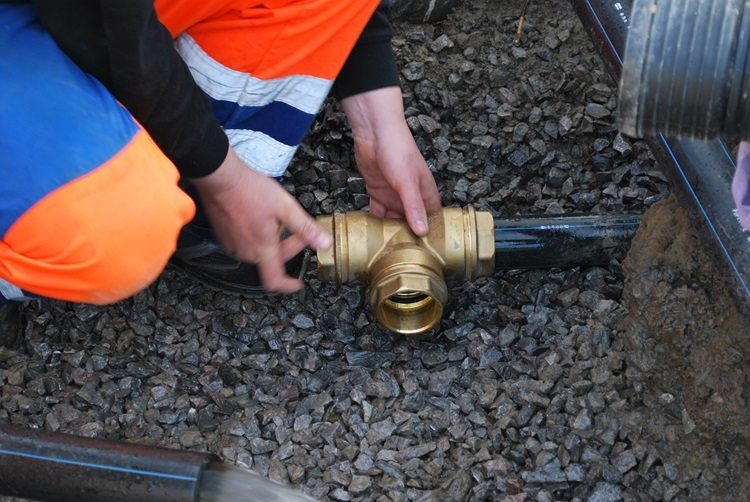
Connection using compression fittings is one of the fastest methods for installing water pipes from HDPE pipes
One of the most reliable types of connection of PE pipes for water supply is welding. For its implementation, special apparatusesthat connect the ends of the PND products heated to the required temperature. It is important to ensure even pipe sections. Welded joints can be used for laying water pipes in the ground.
Due to the wide variety of types of fittings (couplings, tees, elbows, transitions to threads, flanges, etc.), pipelines of any configuration can be assembled using polyethylene products. Since such connections require maintenance during operation, laying in the ground is not recommended.
For electrofusion welding, special thermoresistive fittings are used. Their design feature is the presence of sensors and a heating coil. There are terminals on the surface for connecting the welding machine. Pipes are prepared, their ends are inserted into the fitting. The welding mode is applied to the barcode read by the welding machine. After starting, the inner spiral heats up, melting the material of the pipe and fitting. Such a connection can be laid in the ground. Flange joining is used to switch to other types of pipes.
Easy installation and high quality material allows installation of polyethylene pipes for the water supply in the country independently, without the involvement of specialists and unnecessary costs.
